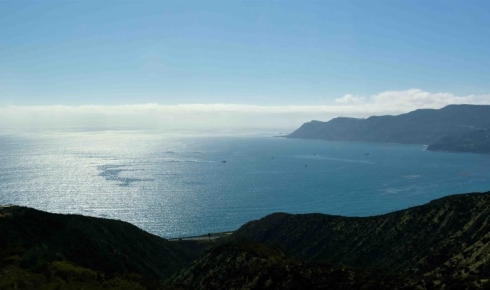Baja Wine Country: Aging Well
by Susan Montgomery
Our recent venture into Baja Mexico’s Valle de Guadalupe for a tour of several wineries was an exceptional experience. The stark desert beauty of the region, the gracious hospitality of our hosts, and the excellence of the wines were beyond anything we had anticipated.
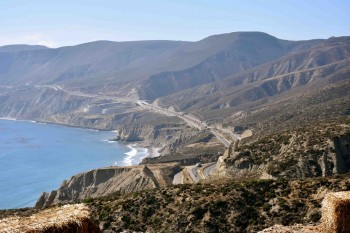 Valle de Guadalupe is easily accessible from the San Diego or Los Angeles areas since it is only a couple of hours from the California/Mexico border and 14 miles north of the city of Ensenada. The drive to the valley from the border offers breath-taking views of lofty mountain ranges rising dramatically above waves crashing into the rocky coastline. The valley runs about 12 miles inland from the Pacific Ocean and is accented with granite boulders, reminding us that this was once ocean floor. At a 1000-foot elevation, the area offers an ideal grape growing climate, similar to southern California, with very hot days in the summer but ocean breezes that bring cool nights throughout most of the year. The daily temperature differential can be more than 40 degrees.
Valle de Guadalupe is easily accessible from the San Diego or Los Angeles areas since it is only a couple of hours from the California/Mexico border and 14 miles north of the city of Ensenada. The drive to the valley from the border offers breath-taking views of lofty mountain ranges rising dramatically above waves crashing into the rocky coastline. The valley runs about 12 miles inland from the Pacific Ocean and is accented with granite boulders, reminding us that this was once ocean floor. At a 1000-foot elevation, the area offers an ideal grape growing climate, similar to southern California, with very hot days in the summer but ocean breezes that bring cool nights throughout most of the year. The daily temperature differential can be more than 40 degrees.
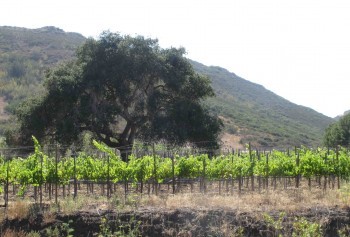 Surprisingly, most of the Guadalupe winemakers we visited were not too concerned about the current drought affecting the area. Last year only three inches of rain fell in the valley while this year they have had more than four times that amount, although the region is still facing drought conditions. Most of the wineries have determined the minimum amount of water needed to nurture growing grapes and are adhering to that amount of irrigation. After all, vines that struggle a bit usually produce wonderful grapes.
Surprisingly, most of the Guadalupe winemakers we visited were not too concerned about the current drought affecting the area. Last year only three inches of rain fell in the valley while this year they have had more than four times that amount, although the region is still facing drought conditions. Most of the wineries have determined the minimum amount of water needed to nurture growing grapes and are adhering to that amount of irrigation. After all, vines that struggle a bit usually produce wonderful grapes.
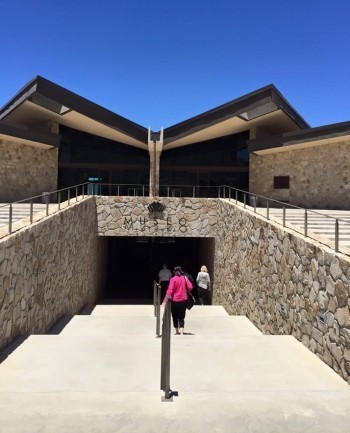 Winemaking in the Guadalupe Valley began in the 1600s when the Spanish brought vines from Europe, making it the oldest winemaking region in the Americas. Many of the earliest vineyards were planted by missionaries and later in the early 20th century Russian immigrants established their own winemaking traditions. Some of these original vineyards still exist. Winemaking over the years has become the economic centerpiece of the region and recently wineries have been increasing and thriving. The valley has now designated its own wine trail, highlighted by a modern, enlightening museum, Museo de la Vid y el Vino, which traces the history and growth of the Baja wine region.
Winemaking in the Guadalupe Valley began in the 1600s when the Spanish brought vines from Europe, making it the oldest winemaking region in the Americas. Many of the earliest vineyards were planted by missionaries and later in the early 20th century Russian immigrants established their own winemaking traditions. Some of these original vineyards still exist. Winemaking over the years has become the economic centerpiece of the region and recently wineries have been increasing and thriving. The valley has now designated its own wine trail, highlighted by a modern, enlightening museum, Museo de la Vid y el Vino, which traces the history and growth of the Baja wine region.
While there are more than 90 wineries in the area, we only had time to visit five, but they were all unique and offered special wine tasting experiences to our group of food and wine writers on a two-day tour.
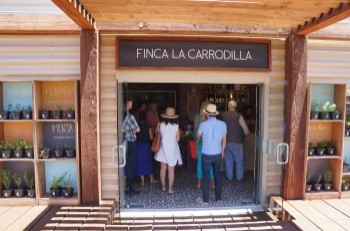 The first winery and also the newest winery we visited was Finca La Carrodilla, sister winery of Hacienda La Lomita. We were greeted by personable Fernando Pérez Castro, whose family owns both wineries and who is passionate about the wines they produce. At this point, Finca La Carrodilla is the only organically certified winery in the valley. I knew I really liked Fernando when he emphasized that wine is a “necessity of life” that he loves sharing with his friends and visitors.
The first winery and also the newest winery we visited was Finca La Carrodilla, sister winery of Hacienda La Lomita. We were greeted by personable Fernando Pérez Castro, whose family owns both wineries and who is passionate about the wines they produce. At this point, Finca La Carrodilla is the only organically certified winery in the valley. I knew I really liked Fernando when he emphasized that wine is a “necessity of life” that he loves sharing with his friends and visitors.
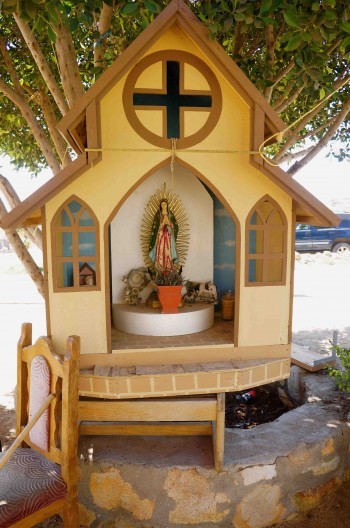 We learned that Fernando’s mother named the winery after the Virgin of La Carrodilla, protector of wines in the famous wine region of Mendoza, Argentina. A shrine to this saint watches over a lovely roof garden on the upper level of the winery. The saint must be doing a good job of overseeing this winery since the wines we tasted were all outstanding.
We learned that Fernando’s mother named the winery after the Virgin of La Carrodilla, protector of wines in the famous wine region of Mendoza, Argentina. A shrine to this saint watches over a lovely roof garden on the upper level of the winery. The saint must be doing a good job of overseeing this winery since the wines we tasted were all outstanding.
A modern but warm architectural style made us all feel welcomed in the tasting room. We learned that the crushing of grapes takes place on the top level of the winery, next to the tasting room, while the fermentation, aging and bottling take place below in cooler temperatures.
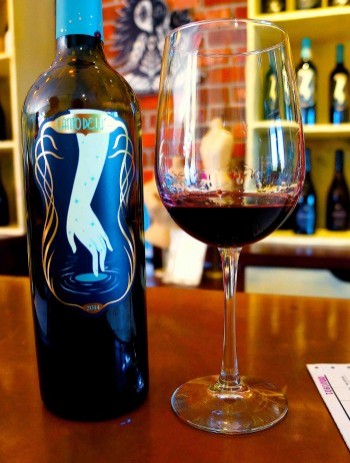 We first sampled one of the few white wines we tasted during our wine tour—a fruity but still crisp 2012 Chenin Blanc with tropical aromas. I could easily imagine savoring this refreshing wine with cheese or fish. We also enjoyed the 2014 Canto de Luna, a jammy but earthy blend of Shiraz, Cabernet Sauvignon and Tempranillo. Strong on tannins with a subtle nuttiness, this wine was a winner. We also enjoyed the 2012 Shiraz, which was mellow, fruity and flavorful with a subtle smokiness. My favorite was the well-balanced, berry-flavored 2012 Cabernet Sauvignon, the only La Carrodilla wine aged in French Oak.
We first sampled one of the few white wines we tasted during our wine tour—a fruity but still crisp 2012 Chenin Blanc with tropical aromas. I could easily imagine savoring this refreshing wine with cheese or fish. We also enjoyed the 2014 Canto de Luna, a jammy but earthy blend of Shiraz, Cabernet Sauvignon and Tempranillo. Strong on tannins with a subtle nuttiness, this wine was a winner. We also enjoyed the 2012 Shiraz, which was mellow, fruity and flavorful with a subtle smokiness. My favorite was the well-balanced, berry-flavored 2012 Cabernet Sauvignon, the only La Carrodilla wine aged in French Oak.
The winery’s 20-acre, artfully landscaped property included lush vineyards and an extensive, organic herb and vegetable garden that we toured with agronomist, Jimena Rabago. As we munched on delicious vegetables right out of the garden, we learned that most of the produce goes to local restaurants. (I’ve never tasted such a fresh, flavorful carrot.) The property also nurtures chickens, cows, sheep and bees.
All of Finca La Carrodilla’s new releases are available in the United States through LMA Wines, a boutique wine distributor in San Diego.
La Cooperativa, La Escuelita, Estación de Oficios el Porvenir
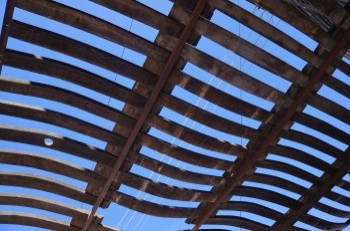 Centrally located in the Valle de Guadalupe, this fascinating wine production facility and co-op wine school was founded by wine pioneer, Hugo d’Acosta, to help Baja winegrowers save their grapes and produce good wine. The winery’s focus on recycling was all around us. An impressive tower is made of barrel staves. Several buildings in the complex are constructed of adobe mud reinforced with old bed springs and wine bottles, along with scraps of wood from other projects. These buildings are actually works of art.
Centrally located in the Valle de Guadalupe, this fascinating wine production facility and co-op wine school was founded by wine pioneer, Hugo d’Acosta, to help Baja winegrowers save their grapes and produce good wine. The winery’s focus on recycling was all around us. An impressive tower is made of barrel staves. Several buildings in the complex are constructed of adobe mud reinforced with old bed springs and wine bottles, along with scraps of wood from other projects. These buildings are actually works of art.
The school, La Escuelita, offers classes on four consecutive Saturdays beginning toward the end of August. Classes, which are all in Spanish, focus on the principles of viticulture and winemaking, and students have the facilities to make their own wine. Since almost all the students come from the valley, there is no question that this school has had a major positive impact on the quality of wine being produced in the area.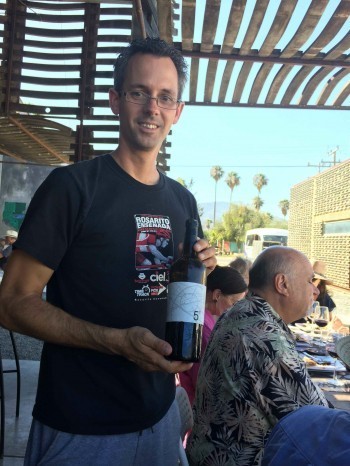
D’Acosta’s knowledgeable assistant, Tomas Eglin, showed us how wine is made. Grapes from wineries all over the valley are manually punched down in open-topped concrete tanks and then fermented. The winery even distills grappa, makes olive oil and brews craft beer.
We enjoyed cold craft beers as we toured the facility and then we sat down in the pleasant outdoor dining area at La Cooperativa to sample wine paired with delicious crab burritos and a fresh green salad. We savored 2014 Estación Porvenir Vino Blanco, a crispy, light Sauvignon Blanc (perfect for a hot day) with hints of apple and stone fruit. 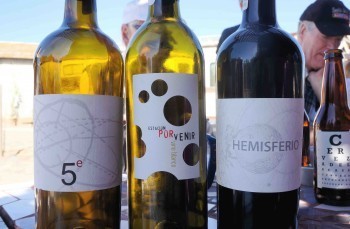 5 Estrellas, a mellow red blend, was made onsite in 2009 and represents the five varietals in the wine—Tempranillo (an abundant grape in the valley), Cabernet Sauvignon, Cinsault, Merlot and Grenache. It was a flavorful, smooth blend that went down easily and complemented the crab and the salad. We concluded the wine tasting with Acrata 2008, made by Hugo d’Acosta. A rich, red blend of Grenache and Carigan along with a bit of Petite Sirah, this wine was bolder than the other wines with a creamy texture and nice fruity flavors.
5 Estrellas, a mellow red blend, was made onsite in 2009 and represents the five varietals in the wine—Tempranillo (an abundant grape in the valley), Cabernet Sauvignon, Cinsault, Merlot and Grenache. It was a flavorful, smooth blend that went down easily and complemented the crab and the salad. We concluded the wine tasting with Acrata 2008, made by Hugo d’Acosta. A rich, red blend of Grenache and Carigan along with a bit of Petite Sirah, this wine was bolder than the other wines with a creamy texture and nice fruity flavors.
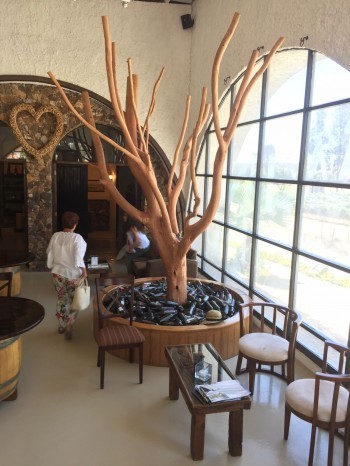 This beautifully landscaped boutique winery with 18 acres of vineyards has a rich history. It was founded by dedicated winegrower Eduardo Liceago Campos and his wife, Myrna. Eduardo passed away in 2007, but Myrna continues to carry on the tradition of producing excellent wines. Although the winery’s production of about 2500 cases a year is small, its outstanding reputation for producing exquisite wine is widespread. Perhaps its most famous wine is called Etiqueta L, an elegant, full-flavored Syrah and Merlot blend that pairs especially well with red meat.
This beautifully landscaped boutique winery with 18 acres of vineyards has a rich history. It was founded by dedicated winegrower Eduardo Liceago Campos and his wife, Myrna. Eduardo passed away in 2007, but Myrna continues to carry on the tradition of producing excellent wines. Although the winery’s production of about 2500 cases a year is small, its outstanding reputation for producing exquisite wine is widespread. Perhaps its most famous wine is called Etiqueta L, an elegant, full-flavored Syrah and Merlot blend that pairs especially well with red meat.
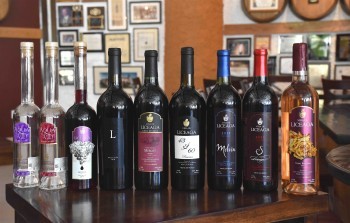 Our gracious wine tasting host at Liceaga was Is-Boset Acfosta Flores. He first poured a subtly floral, beautifully-hued Rosé, Rosa de Liceaga, a light blend of Merlot, Grenache and Syrah. The 43/60 (Eduardo was born in 1943 and Myrna in 1960) is a complex blend of Cabernet Sauvignon, Syrah and Merlot with nice tastes of cherry, blackberry, coffee and chocolate. We also enjoyed Melvin (named after the family’s middle son), a 100 percent Cabernet Sauvignon that was intense and fruity with hints of spice and a long finish.
Our gracious wine tasting host at Liceaga was Is-Boset Acfosta Flores. He first poured a subtly floral, beautifully-hued Rosé, Rosa de Liceaga, a light blend of Merlot, Grenache and Syrah. The 43/60 (Eduardo was born in 1943 and Myrna in 1960) is a complex blend of Cabernet Sauvignon, Syrah and Merlot with nice tastes of cherry, blackberry, coffee and chocolate. We also enjoyed Melvin (named after the family’s middle son), a 100 percent Cabernet Sauvignon that was intense and fruity with hints of spice and a long finish.
Liceaga is also well known for its award-winning Aqua de Vid, known as “grappa” in Italy and made from red and white grapes. Fragrant, slightly tangy and smooth, this grappa was one of the best I’ve ever tasted.
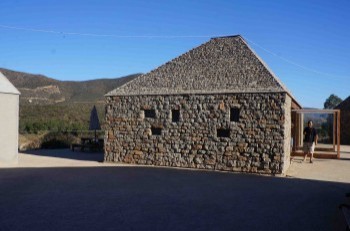 The stunning architecture of this uniquely constructed winery is enough of a reason to visit, but the wines are outstanding too. Designed by innovative architects Alejandro d’Acosta and Claudia Turrent, this dramatic complex of stone buildings sits high on a hill with sweeping views of the valley. Constructed mostly of locally sourced stone and carved out of boulders, this masterpiece is accented with artistic structural details featuring recycled wine bottles and wood. Wine bottles are used in windows and skylights, creating an ever-changing interplay of colorful light and shadows as the sun moves across the courtyard. If I didn’t know better, I would think I was entering the private, pyramid-like retreat of an ancient Mayan king, but this winery just opened in 2014.
The stunning architecture of this uniquely constructed winery is enough of a reason to visit, but the wines are outstanding too. Designed by innovative architects Alejandro d’Acosta and Claudia Turrent, this dramatic complex of stone buildings sits high on a hill with sweeping views of the valley. Constructed mostly of locally sourced stone and carved out of boulders, this masterpiece is accented with artistic structural details featuring recycled wine bottles and wood. Wine bottles are used in windows and skylights, creating an ever-changing interplay of colorful light and shadows as the sun moves across the courtyard. If I didn’t know better, I would think I was entering the private, pyramid-like retreat of an ancient Mayan king, but this winery just opened in 2014.
Massive concrete chairs (installation art?) in a central courtyard invited us to sit down, contemplate life, and sip for a bit —as did the passionate and hospitable owners, Maria Benitez Cantarero and Joaquin Moya Cussi, who welcomed us with infectious enthusiasm about the dazzling property they have created. They were obviously successful in their goal of creating a winery that merges almost organically with its beautiful surroundings.
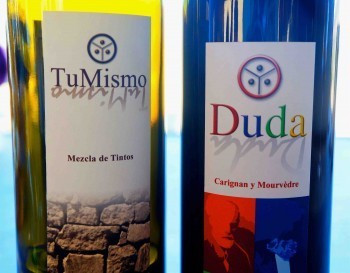 Even the names of the wines are innovative and introspective. We enjoyed Tu Mismo 2013 (meaning yourself), a well-balanced red blend; Duda 2013 (meaning doubt), a rich blend of Carignan and Mourvedre; and Nada (meaning nothing), a spicy, fruity Tempranillo and Petite Syrah blend.
Even the names of the wines are innovative and introspective. We enjoyed Tu Mismo 2013 (meaning yourself), a well-balanced red blend; Duda 2013 (meaning doubt), a rich blend of Carignan and Mourvedre; and Nada (meaning nothing), a spicy, fruity Tempranillo and Petite Syrah blend.
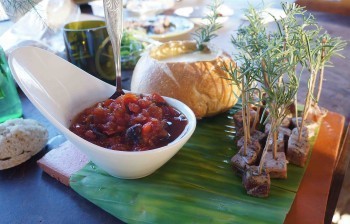 These wines paired well with a beautifully presented, delectable array of gourmet appetizers prepared for us by the winery’s talented chefs. We savored shrimp on crispy pork rind with apples and peppers, seared tuna on rosemary that we dipped into a creamy cheese mixture, and king crab mixed with Dijon mustard and dill on crisp jicama slices. If these treats are any indication, the winery’s restaurant, slated to open soon, will give us even more of a reason to visit again. As we departed, with the sun setting dramatically over the valley, I promised myself that we will visit Clos de Tres Cantos again.
These wines paired well with a beautifully presented, delectable array of gourmet appetizers prepared for us by the winery’s talented chefs. We savored shrimp on crispy pork rind with apples and peppers, seared tuna on rosemary that we dipped into a creamy cheese mixture, and king crab mixed with Dijon mustard and dill on crisp jicama slices. If these treats are any indication, the winery’s restaurant, slated to open soon, will give us even more of a reason to visit again. As we departed, with the sun setting dramatically over the valley, I promised myself that we will visit Clos de Tres Cantos again.
 Located near Ensenada, Cuatro Cuatros also has a spectacular site for a winery, with vineyards right on the cliffs overlooking the Pacific. With a multi-leveled, spacious open-air bar overlooking the ocean, it’s hard to imagine a more inspiring place to be sipping wine. Because this mountaintop location is only accessible via a bumpy dirt road, the winery provides transportation up and back. Since its location is cooler on the ocean, the site offers a unique micro-climate for the vineyards.
Located near Ensenada, Cuatro Cuatros also has a spectacular site for a winery, with vineyards right on the cliffs overlooking the Pacific. With a multi-leveled, spacious open-air bar overlooking the ocean, it’s hard to imagine a more inspiring place to be sipping wine. Because this mountaintop location is only accessible via a bumpy dirt road, the winery provides transportation up and back. Since its location is cooler on the ocean, the site offers a unique micro-climate for the vineyards.
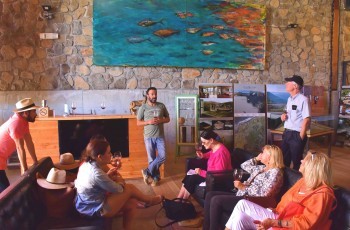 Since the winery’s production of 700 cases is very small, its wines are only sold onsite so tasting these wines was a special treat. Andrés Blanco was our congenial, knowledgeable guide to wine tasting. We tasted a dry, earthy 2013 Sauvignon Blanc with a bit of tang and a lovely floral bouquet. We also enjoyed a pale pink, subtly sweet Grenache that had been aged for a year in oak. The richest wine we sampled here (and loved) was a well-balanced blend of Tempranillo, Merlot and Cabernet Sauvignon. This winery also offers guests an upscale “glamping” option in 14 cabanas that feature stylish comfort and all the amentities of a hotel room.
Since the winery’s production of 700 cases is very small, its wines are only sold onsite so tasting these wines was a special treat. Andrés Blanco was our congenial, knowledgeable guide to wine tasting. We tasted a dry, earthy 2013 Sauvignon Blanc with a bit of tang and a lovely floral bouquet. We also enjoyed a pale pink, subtly sweet Grenache that had been aged for a year in oak. The richest wine we sampled here (and loved) was a well-balanced blend of Tempranillo, Merlot and Cabernet Sauvignon. This winery also offers guests an upscale “glamping” option in 14 cabanas that feature stylish comfort and all the amentities of a hotel room.
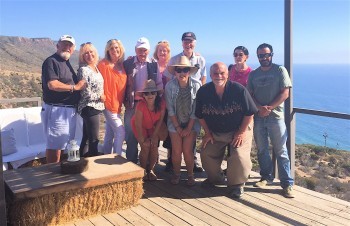 Our happy group of wine writers (pictured right) reluctantly left Valle de Guadalupe, impressed with the quality of the wine we tasted and confident that we'll all be back since we had only explored a few of the unique wine tasting options available in the valley.
Our happy group of wine writers (pictured right) reluctantly left Valle de Guadalupe, impressed with the quality of the wine we tasted and confident that we'll all be back since we had only explored a few of the unique wine tasting options available in the valley.
Because some of these wineries are only open during limited hours and since hours of opening can change, I suggest calling in advance to either make an appointment or to confirm hours. Also, you can go to the Discover Baja California website at http://www.discoverbajacalifornia.com/ for many details about getting to Baja, crossing the border and finding accommodations.
Phone numbers for each of the wineries we visited:
Cuatro Cuatros: (52) 646-174-6789
Cooperativa: (52) 646-156-5268
Finca La Carrodilla: (52) 646-156-8052
Vina de Licega: (52) 646-178-2922
Clos de Tres Cantos Winery: (52) 558-568-9240
Photos taken by Todd Montgomery

